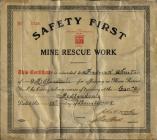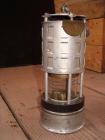1
Certificate of mine rescue awarded to Frederick R. Smith, no.172618 December 1928
 Credits:
Credits:Workmens Compensation Board of Alberta
2
When one decides to become a coal miner they also accept the risks involved in the profession, like deadly gases, cave-ins and explosions. Miners in the Drumheller Valley had their share of accidents, but in seven decades of mining had only one mine disaster. To be classified as a "disaster," 4 or more men must be killed in one event.Mining accidents were common in the valley. They could be deadly and horrible. Countless men were injured in rockfalls, and even more were crushed by the weight of a loaded coal car. If a miner was injured on the job, he was sent to the on site doctor for an examination. If the doctor felt the injured party should receive medical attention at a hospital, the man was taken to Wayne by coal truck, train or ambulance, if not he went home. If the injured miner died at home or in the care of the hospital, the mine was not always seen to be at fault, and the death might not be recorded as a mine fatality.
3
William Makarenko smoking cigarette cleaning his carbide lamp on the bench outside his house1949
 Credits:
Credits:Atlas Coal Mine Historical Society
5
The Atlas Coal Mine had one of the best safety records in the valley. In the 62 years that the Atlas Mines operated in the valley, there were only 13 mine fatalities recorded.June 24, 1941 was the date of a true mining disaster that was felt throughout the entire Drumheller Valley. Around 5:30pm an explosion took place at the Monarch Mine in East Coulee, with three men inside. A miner's wife heard the explosion and ran towards the nearest mine, the Atlas, to get help. She notified the mine manager, Harry Crowder, and he began phoning the neighbouring mines to assemble a rescue team. In addition, Harry called the main valley rescue team to come out from Drumheller. Due to the dangers of toxic gas in the aftermath of an explosion, this team brought a mine canary. Canaries are very sensitive to gas, and were the best way to test a mine for safety.
However, waiting for the valley's main team to arrive would cost them precious time. Once Harry had his team assembled they entered the mine, following his lead. They all returned to the surface. Unfortunately Harry, with the hope of saving lives, entered the mine a second time. This time alone, he would not return.
In the investigation, it was theorized that Harry tripped when passing through coal cars and in the process knocked his breathing apparatus loose causing exposure to the noxious gasses which are believed to have lead to his death.
Mining accidents were frequent and there had been three killed in previous tragedies, but never four. In this disaster, the explosion took three men. Harry Crowder's fatality made the death toll four, a first in valley history. This accident resulted in mandatory daily gas inspections in each mine, and the use of safety lamps across the valley.
"Every winter someone was killed in the mines in the process of mining coal. In fact, one funeral I was at, the preacher pointed out to the congregation ? that some people die every winter so that you can keep your houses warm and cook your meals."
- John Young- Retired Drumheller Valley Coal Miner.
6
First Aid Certificate awarded to Fredrick R. Smith, No. 11230Dec 1929
 Credits:
Credits:Atlas Coal Mine Historical Society
